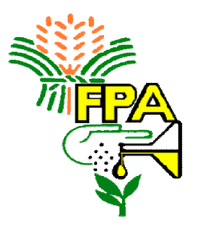Fertilizer and Pesticide Authority
| Pangasiwaan sa Pataba at Pestisidyo | |
|
FPA Logo | |
| Attached Agency overview | |
|---|---|
| Formed | 30 May 1977 |
| Preceding Attached Agency |
|
| Type | executive agency |
| Jurisdiction | Government of the Philippines |
| Headquarters |
FPA Building, Bureau of Animal Industry (BAI) Compound, Visayas Avenue, Vasra, Quezon City 14°39′24.77″N 121°2′49.2″E / 14.6568806°N 121.047000°E |
| Annual budget | P57.903 million (2013)[1] |
| Minister responsible |
|
| Attached Agency executive |
|
| Parent Attached Agency | Office of the President of the Philippines |
| Website |
www |
The Philippines' Fertilizer and Pesticide Authority (Filipino: Pangasiwaan sa Pataba at Pestisidyo, abbreviated as FPA), is a technical regulatory agency of the Philippine Department of Agriculture under the Office of the President of the Philippines through the issuance of Executive Order 165 on May 5, 2014. The agency is responsible for assuring adequate supply of fertilizer and pesticide at reasonable prices; rationalizing the manufacture and marketing of fertilizer; protecting the public from the risks of the inherent use of pesticides; and educating the agricultural sector in the use of these inputs.
History
In 1972–1973, Philippines was beset by rice production shortfalls resulting from the series of typhoons and floods and fertilizer shortages spawned by the oil crisis. The resulting fourfold drop in rice production prompted the government to directly intervene in the operations of the fertilizer industry through the issuance of Presidential Decree (P.D.) No. 135 dated 22 February 1973, creating the Fertilizer Industry Authority (FIA).[2]
Fertilizer and pesticide are vital agricultural inputs in food production and must be supplied in adequate quantities at reasonable costs at all times. The fertilizer and pesticide industries have much in common in terms of clientele, distribution channels, system of application in farmers' fields and technical supervision by the same farm management technicians under the government's food production program. In view hereof, the government abolished the FIA and created the Fertilizer and Pesticide Authority on 30 May 1977 by virtue of P.D. 1144.
The FPA is mandated to assure adequate supplies of fertilizer and pesticide at reasonable prices; rationalize the manufacture and marketing of fertilizer; protect the public from the risks inherent in the use of pesticides; and educate the agricultural sector in the use of these inputs. It is attached to the Department of Agriculture until on May 5, 2014 President Benigno C. Aquino issued an Executive Order 165 transferring FPA and the three other agencies-NIA, PCA and NFA to the Office of the President of the Philippines.
Vision
Sustained agricultural productivity in a wholesome environment through integrated plant nutrients management and safe crop protection systems.
Mission
To be a catalyst in the empowerment of farmers and fisherfolk by helping them become better informed, and more efficient and conscientious in the management of their plant nutrition and crop protection requirements and preservation of marine and aquatic resources to increase their agricultural productivity, increase income and assist the Philippine government in its sustainable development plan including its goal on rice sufficiency.
Strategic Thrusts
- .Integrated Plant Nutrition System [IPNS] -a systematic approach that relates plant nutrition needs to actual soil fertility condition.
- .Integrated Crop Protection System [ICPS] -holistic crop protection system that relates farm productivity to the protection of human health and the environment.
- .Empowerment of Farmers/ Fisherfolk – helping farmers/fisherfolk become more self-reliant in meeting their needs for vital agricultural inputs.
- .Close Networking with Stakeholders in Achieving Sustainable Farm Productivity thru IPNS & ICPS.
Program Thrusts
- .Empower farmers/fisherfolk
- .Protect human health and the environment
- .Use indigenous resources
- .Develop and sustain partnership with all stakeholders.
Institutional Activities
- .Regulation of the fertilizer and pesticide industries
– efficacy and quality standards – environmental impact – product safety and agri-occupational health
- .Outreach services for farmers/ fisherfolk
– plant Health Clinics – on-site capability-building programs
- .R & D
– organic fertilizers – natural pesticides
- .Monitoring of pesticide residues in selected crops
- .Public Information Campaign
– health and environmental information – techno-tips
- .Crop Pest Infestation Monitoring
References
- ↑ "Allocated Budget in the 2012 General Appropriations Act for the Fertilizer and Pesticide Authority" (PDF). Department of Budget and Management. Retrieved 21 February 2013.
- ↑ "About the Fertilizer & Pesticide Authority". Archived from the original on 14 March 2009. Retrieved 21 February 2013.
